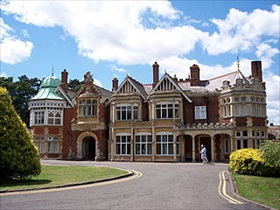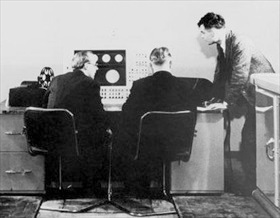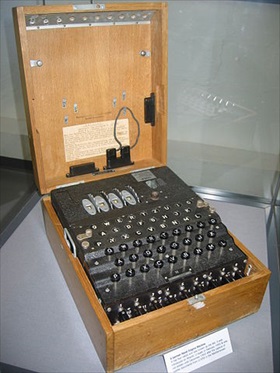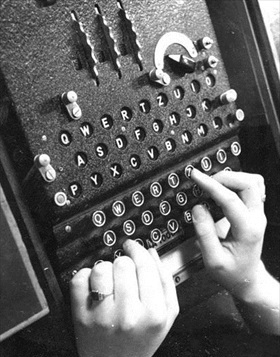NAZI ENCRYPTION DEVICE, CODES SEIZED
Bletchley Park, England · May 9, 1941
As war loomed in Europe, British codebreakers based at Bletchley Park outside London worked feverishly to unravel the Enigma cipher machine, which the Germans used to encrypt their most secret communications. The Enigma had a number of differently wired scrambler rotors that operators changed and shuffled through billions of permutations, making the encoded text infuriatingly difficult to decipher.
In late July 1939, just over a month before the Wehrmacht (German armed forces) attacked Poland, the Poles delivered a Polish-reconstructed Enigma machine, along with details of the equipment, to Bletchley Park. This gift was the springboard that allowed the oddball set of British mathematicians, linguists, and scientists to repeatedly break the far more complicated and thus secure systems introduced after war broke out.
On this date, May 9, 1941, British retrieved a naval Enigma encoding machine, operating instructions, manuals, codebooks, a stack of messages sent and received, and the rotor settings (encryption keying tables) then in use from a German submarine (U‑110) captured off Iceland. (Praying that the Germans not find out about the U‑boat’s capture and change all naval codes and the cipher system, the British scuttled the submarine as it was being towed to Britain.) Two days earlier codebooks and documents on the operation of the Enigma machine fell into British hands when an enemy weather ship was captured in the North Atlantic. Over a year later another U‑boat’s Enigma machine and the immensely valuable codebooks with all current settings for the encryption key were conveyed to Bletchley Park.
The combination of the two May 1941 captured prizes allowed British cryptologists to eventually read the different wartime Enigma codes used by the German army, navy, and air force. Within months intelligence from the decrypts (called Ultra) allowed the Allies to reroute many merchant convoys past U‑boats in the North Atlantic, saving hundreds of lives and hundreds of thousands of tons of vital shipping. It also began to tip the Battle of the Atlantic in the Allies’ favor in that the hunted now became the hunters. In May 1943 alone, 43 enemy subs were sunk, bringing the total to 100 since the start of the year. So great was the stepped-up offensive by Allied submarines and escort carrier- and land-based aircraft that Adm. Karl Doenitz, commander-in-chief of the Kriegsmarine, withdrew his U‑boats from the Atlantic for a time. British Prime Minister Winston Churchill, whose island population was close to being starved by the U‑boat menace, called cracking the German Enigma code the “secret weapon” that won the war.
Bletchley Park and Decoding the Enigma
 |  |
Left: Bletchley Park, top-secret headquarters of Britain’s Government Code and Cypher School, where ciphers and codes of several Axis countries were decrypted. This mock-Tudor mansion, with its surrounding buildings (“huts”), was home to as many as 10,000 men and women during the war, including Britain’s most brilliant mathematical brains, and was the scene of immense advances in computer science and modern computing. Churchill referred to the Bletchley staff as “the geese that laid the golden eggs and never cackled.”
![]()
Right: Alan Turing (standing) was an English mathematician and wartime codebreaker. At Bletchley Park, Turing (1912–1954) took the lead in a team that designed an electromechanical machine known as a “bombe” that successfully broke German ciphers. Turing is widely considered to be the father of computer science and artificial intelligence. The commercially and critically successful 2014 film The Imitation Game, starring Benedict Cumberbatch, is loosely based on the role Turing and his cryptanalysts played in solving the Enigma code. On June 23, 2021, the anniversary of his birthday in 1912, Turing became the new face of Britain’s £50 note, the most valuable denomination in circulation.
 |  |
Left: A four-rotor German naval Enigma on display at Bletchley Park. The combination of the two British-captured cryptographic prizes in May 1941 was crucially important in breaking German U‑boat codes and ultimately in winning the Battle of the Atlantic. One Bletchley Park veteran said that Ultra decrypts shortened the war by two to four years.
![]()
Right: A three-rotor Enigma machine in use by the Luftwaffe, December 1943. Almost to the end of the war, the Germans had firm faith in the Enigma ciphering machine; indeed, Adm. Doenitz had been advised that a cryptanalytic attack on his naval Enigma machines was the least likely of all his security problems. But in fact Allied codebreakers were deciphering nearly 4,000 German transmissions daily by 1942, reaping a wealth of information.
Bletchley Park: Breaking the Unbreakable German Enigma Coding Machine
![]()

 History buffs, there is good news! The Daily Chronicles of World War II is now available as an ebook for $4.99 on Amazon.com. Containing a year’s worth of dated entries from this website, the ebook brings the story of this tumultuous era to life in a compelling, authoritative, and succinct manner. Featuring inventive navigation aids, the ebook enables readers to instantly move forward or backward by month and date to different dated entries. Simple and elegant! Click
History buffs, there is good news! The Daily Chronicles of World War II is now available as an ebook for $4.99 on Amazon.com. Containing a year’s worth of dated entries from this website, the ebook brings the story of this tumultuous era to life in a compelling, authoritative, and succinct manner. Featuring inventive navigation aids, the ebook enables readers to instantly move forward or backward by month and date to different dated entries. Simple and elegant! Click 











